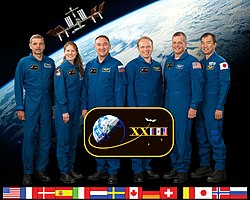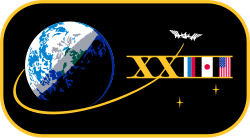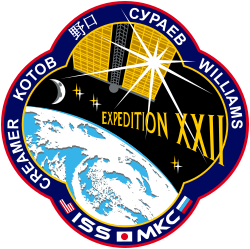Expedition 23
| Expedition 23 | |||
 | |||
| Uppdragsstatistik | |||
|---|---|---|---|
| Rymdstation: | ISS | ||
| Start: | 18 mars 2010, 08:03 UTC[1] | ||
| Slut: | 2 juni 2010, 00:04 UTC[1] | ||
| Tid: | 76 dag 16 tim 1 min | ||
| Antal besättningsmedlemmar: | 6 st | ||
| Transport | |||
| Uppskjutning: | med Sojuz TMA-17, Sojuz TMA-18 | ||
| Uppskjutningsplats: | Kosmodromen i Bajkonur | ||
| Landning: | med Sojuz TMA-17, Sojuz TMA-18 | ||
| Landningsplats: | Kazakstan | ||
| Kronologi | |||
| |||

Expedition 23 var den 23:e expeditionen till Internationella rymdstationen (ISS). Expeditionen började den 18 mars 2010 då sista delen av Expedition 22s besättning återvände till jorden med Sojuz TMA-16.
Aleksandr Skvortsov, Mikhail Korniyenko och Tracy E. Caldwell anlände till stationen den 4 april 2010.
Expeditionen avslutades den 2 juni 2010 då Oleg Kotov, Soichi Noguchi och Timothy J. Creamer återvände till jorden med Sojuz TMA-17.
Under Expedition 23 levererade rymdfärjan Atlantis under flygningen STS-132, den ryska dockningsmodulen Rassvet till rymdstationen.
Besättning
| Position | Första delen (18 mars- 4 april 2010) | Andra delen (4 april - 2 juni 2010) |
|---|---|---|
| Befälhavare | Hans andra rymdfärd | |
| Flygingenjör 1 | Hans andra rymdfärd | |
| Flygingenjör 2 | Hans första rymdfärd | |
| Flygingenjör 3 | Hans andra rymdfärd | |
| Flygingenjör 4 | Hans andra rymdfärd | |
| Flygingenjör 5 | Hennes andra rymdfärd | |
Referenser
- ^ [a b] NASA's Space Station Expedition 23 Arkiverad 28 september 2013 hämtat från the Wayback Machine., läst 28 augusti 2016.
Externa länkar
| |||||||||||||||||||
Media som används på denna webbplats
The focal point of the Expedition XXIII emblem illustrates the beautiful planet Earth in the black expanse of space. The International Space Station (ISS) is shown traveling in its orbit around Earth. The ISS orbital path flies through the XXIII to show that this increment is building upon the missions that have gone on before and laying the groundwork for future missions. This illustrates the work being performed aboard the orbiting complex that will lead the way to eventual missions to the moon, Mars and beyond. The mission designation uses Roman numerals to illustrate the home nations of the crew, which are also represented by their national flags. The two stars represent the two teams that make up this expedition crew.
Expedition 23 crew members. From the left are Russian cosmonaut Mikhail Kornienko, NASA astronaut Tracy Caldwell Dyson, Russian cosmonaut Alexander Skvortsov, all flight engineers; Russian cosmonaut Oleg Kotov, commander; NASA astronaut T.J. Creamer and Japan Aerospace Exploration Agency (JAXA) astronaut Soichi Noguchi, both flight engineers.
The 22nd Expedition to the International Space Station is dedicated to the final stages of assembly and the transition to full utilization as an orbiting laboratory. The sun, providing power and life support to the space station, shines through one of the solar arrays as the ISS orbits above Earth. The oceans and atmosphere, providing life support to Earth, are shown in all their beauty. The moon hovers in the distance as the goal of the next era of exploration. The six stars illustrate the increased capability of the crew complement. In the border are the national flags of the crew members as well as their surnames in their native languages. Expedition XXII continues the effort to acquire the knowledge necessary to extend the reach of exploration from Earth, to the moon and beyond.
The official crew patch for Expedition 24, the 24th long-duration mission to the International Space Station.
- Science and Exploration are the cornerstones of NASA's mission onboard the International Space Station (ISS). This emblem signifies the dawn of a new era in our program's history. With each new expedition, as we approach assembly complete, our focus shifts toward the research nature of this world-class facility. Prominently placed in the foreground, the ISS silhouette leads the horizon. Each ray of the sun represents the five international partner organizations that encompass this cooperative program. Expedition 24 is one of the first missions expanding to a crew of six. These crews, symbolized here as stars arranged in two groups of three, will launch on Soyuz vehicles. The unbroken flight track symbolizes our continuous human presence in space, representing all who have and will dedicate themselves as crew and citizens of the International Space Station.






